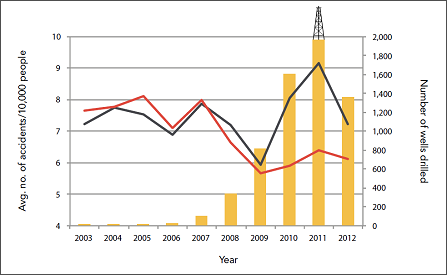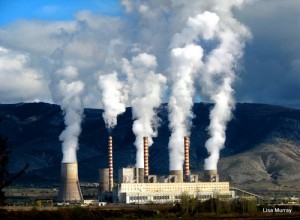RFF ON THE ISSUES: Ukraine energy aid; Belief in climate change
Ukraine Energy Aid
In response to the unfolding Ukrainian crisis, some in the US have advocated using natural gas exports as a way of reducing Russian leverage on Ukraine. However, removing gas export restrictions would still leave the US unable to effectively challenge Russian gas export decisions. In fact, even if the United States had the capacity to export meaningful quantities of liquefied natural gas (LNG), Ukraine does not yet have the terminal and gasification infrastructure to receive shipments of natural gas via the Black Sea. In a recent blog post, RFF’s Joel Darmstadter cites such factors as making it unrealistic to believe that US gas exports could have a “a decisive impact over the next few years, much less on current events.”
Belief in Climate Change
Recently a group of Senate democrats held an all-night session to draw attention to the “impacts of climate change and the benefits addressing it will bring to [the] country.” They called for a need to take action, noting that “climate change is real.”
Results from a new survey by RFF, Stanford University, and USA Today show that a large majority of Americans also believe climate change to be an existing and serious problem, with three out of four respondents stating that it “has occurred in the past century and will likely continue.” RFF President Phil Sharp commented on the consistency of public’s belief in global warming, noting that “hardcore skeptics remain a tiny fraction of the nation.”
A Tale of Two Parks (In One)

Source: Charlie Watson (USAID/Rainforest Alliance Forestry Enterprises) / flickr
Without intending to, the team of civil servants that in 1990 created Guatemala’s Maya Biosphere Reserve (MBR) launched a forest conservation policy experiment. In an ecologically rich region where ranchers and farmers were illegally clearing forests at an astounding clip, they established a huge (two million hectare) protected area with two distinct management regimes—a core protected area where extractive activity is strictly prohibited, and a mixed-use zone where firms and local communities are permitted to harvest timber on the condition that they obtain Forest Stewardship Council certification. Analyzing deforestation in these two zones can help resolve a longstanding debate about tropical forest conservation: how does strict protection perform relative to mixed-use protection?
In principle, each type of regime has advantages and disadvantages. Strict protection prohibits all, instead of just some, extractive activity. However, it is only effective when regulators are willing and able to enforce land cover change restrictions, which is by no means guaranteed in developing countries. In theory, mixed-use protection can sidestep this constraint because it relies more on local organizations to govern land use.
In the MBR, conventional wisdom suggests that mixed-use protection has dramatically outperformed strict protection, because certified community forest concessions in the mixed-use zone have proven able stewards of their forests. In fact, the MBR is often held up as an example of how mixed-use protection and community forestry can be successfully blended.
Can There Be a Positive Prognosis for Climate Negotiations?
This post originally appeared on Robert Stavins’s blog, An Economic View of the Environment.
I’m writing this brief essay on board my flight to the USA from Europe (where I participated in a workshop at the Center for European Economic Research (ZEW) in Mannheim, Germany). It was an interesting event, the substance of which (the “energy-efficiency paradox”) I will write about in the future, but today’s post is stimulated by a news article I read on board my flight, titled, “U.S. and China May Find Agreements Outside Stymied Climate Talks.”
Bad News from Bonn
In Bonn this past week, international negotiations continued under the United Nations Framework Convention on Climate Change (UNFCCC). The two most important countries in terms of greenhouse gas (GHG) emissions – China and the United States – apparently engaged in a war of words on the fundamental question of who should do what. In particular, these two giants – and their respective allies in the developed and developing worlds – bickered over their very different interpretations of the Durban Platform for Enhanced Action’s call for an agreement to be reached in Paris in 2015 that is “applicable to all Parties” (countries).
The United States and other industrialized countries have insisted that this calls for an agreement with emissions reduction pledges by all countries (in particular, by the industrialized countries plus the large emerging economies of China, India, Brazil, Korea, Mexico, and South Africa). But China, India, and most countries in the developing world have maintained that because the Durban Platform was adopted under the auspices of the UNFCCC, it calls only for emission reduction commitments by the industrialized countries. In previous essays at this blog, I’ve written about the potential promise that the Durban Platform can offer for a departure from the paralysis that has characterized the past 15 years under the Kyoto Protocol with its dichotomous distinction between emissions-reductions commitments for industrialized (Annex I) countries and no such commitments for other nations. But it is difficult to claim that the rhetoric in Bonn has been encouraging in that regard.
This Week in the RFF Library Blog
Each week, we review the papers, studies, reports, and briefings posted at the “indispensable” RFF Library Blog, curated by RFF Librarian Chris Clotworthy. Check out this week’s highlights below:
Keystone XL: Greenhouse Gas Emissions Assessments in the Final Environmental Impact Statement
On June 25, 2013, President Obama announced a national “Climate Action Plan” to reduce emissions of carbon dioxide (CO2) and other greenhouse gases (GHG), as well as to encourage adaptation to climate change. During his speech, the President made reference to the proposed Keystone XL Pipeline project—a pipeline that would transport crude oil derived from Canadian oil sands deposits in Alberta… — via Congressional Research Service
Climate Change Mitigation Through Livestock System Transitions
The livestock sector contributes significantly to global warming through greenhouse gas (GHG) emissions. At the same time, livestock is an invaluable source of nutrition and livelihood for millions of poor people. Therefore, climate mitigation policies involving livestock must be designed with extreme care. Here we demonstrate the large mitigation potential inherent in the heterogeneity of… — via Proceedings of the National Academy of Sciences
Gauging the Distributional Consequences of Public Policies
Although we know that public policies have different effects across a population, examination of the distributional effects has been largely neglected. Instead, the principal criteria now used in public policy assessments are measurements of net benefits, which estimate the sum of a policy’s benefits minus its costs, and benefit–cost ratios. But using these criteria can result in a policy that is viewed as having positive overall effects while still generating many more losers than winners, obscuring its true welfare impact.
In order to better understand the true welfare effects of public policies, together with my colleagues, we explore in a new RFF discussion paper how a disaggregated general equilibrium model helps us better understand the ways that policies affect people at various locations and income levels. To do this, we use a computable general equilibrium model (CGE) developed at RFF known as the Land Use, Surface Transportation, and Regional Economics (LUSTRE) model, which simulates urban transportation and land policies in a complex and realistic setting. In our examination of data from the DC metro area, we demonstrate how this model could shed light on policy distribution outcomes by using it to compare the outcomes of four local anti-sprawl policies. These include three variants of “Live Near Your Work” (LNYW) policies, in which homeowners are offered modest subsidies for home or employment relocation to reduce commuting costs, and a vehicle miles traveled (VMT) tax, which taxes a driver’s total miles in a metropolitan area.
Research Questions for the Midterm CAFE Review
Source: TheKarenD / flickr
Our country is about to enter the most important period this decade for the future of transportation and its associated greenhouse gas (GHG) emissions. Fuel economy and GHG standards for both light-duty vehicles and heavier trucks are slated to tighten, reducing not only oil use but also GHG emissions. There is significant uncertainty about how much truck standards will tighten, but fuel economy standards for light-duty vehicles are due to become much stricter over the next decade, cutting GHG emissions from the new car fleet to close to half of their current level by 2025. A mandated midterm review will reevaluate the basis for these tighter standards, drawing on evidence and studies since the original evaluation was performed.
The light-duty vehicle standards were mandated in 2012, by the US Environmental Protection Agency (EPA) for GHGs and by the Department of Transportation’s National Highway Traffic Safety Administration (NHTSA) for fuel economy. The standards are “harmonized” by the two agencies (see note below) and will continue to tighten through 2025 culminating in a 54.5 mpg new car fleet average standard (relative to a 2011 standard of 27 mpg), and the reduction of GHGs by 50 percent. Part of the negotiation over the final rule was that the standards would be revisited through a full evaluation of the last years covered by the rule, model years 2022–2025 by November 15, 2017, with final decisions by the agencies by April 1, 2018—the mid-term CAFE review.
Resources Magazine: Opportunities for Natural Gas in the Light-Duty Fleet
Natural gas prices in the United States have dropped almost 50 percent over the last decade thanks to the shale gas revolution. Oil prices, on the other hand, have more than doubled during that time. The change in the relative prices of these two fuels—combined with significant advances in both fuel and vehicle technologies—creates an opportunity to expand the use of natural gas in the light-duty fleet of cars and trucks and lower prices at the pump. Ethanol, methanol, compressed natural gas (CNG), and liquid petroleum gas (LPG) are four natural gas–based fuels that may be able to do just that.
Although these fuels could yield significant cost savings relative to conventional gasoline in the light-duty fleet, the principal beneficiaries of these fuel and technology trends are currently limited to the estimated 250,000 owners of CNG- and LPG-capable vehicles.
Another 10 million flex-fuel vehicles on the road today are capable of burning E85, a blend of 85 percent ethanol and 15 percent gasoline. Although E85 is not currently cheaper on an energy-equivalent basis at the pump than conventional gasoline in most areas, newly developed technologies offer the promise that low-cost, natural gas–derived ethanol can be produced in the future.
In our recent research, we compared the costs of E85 produced using these new technologies with conventional gasoline, estimating the volume of fuel required to propel a vehicle the same distance (expressed in gasoline gallon equivalents). For the most favorable case, E85 could be produced and sold for $0.31 to $0.59 per gasoline gallon equivalent below the current price of gasoline in selected urban areas across the United States. This amounts to annual savings ranging from $157 to $439 for a vehicle driven 15,000 miles per year, depending on a range of assumptions. Based on 2015 fuel price projections by the US Energy Information Administration, these savings could increase substantially in later years.
Read the rest of this article.
This Week in the RFF Library
Each week, we review the papers, studies, reports, and briefings posted at the “indispensable” RFF Library Blog, curated by RFF Librarian Chris Clotworthy. Check out this week’s highlights below:
Facts About North Dakota Fracking and Water Use
The North Dakota Water Commission has issued a report regarding the facts about fracking and water use in the state. The report, “Facts About North Dakota Fracking & Water Use,” outlines several elements of the fracking process used in the state and how those elements are impacted. Water sources used to supply frack jobs in North Dakota include both surface and groundwater. Groundwater sources typically come from freshwater aquifers… — North Dakota Water Commission
H.R. 3370, Homeowner Flood Insurance Affordability Act of 2014
H.R. 3370 would reduce federal flood insurance premium rates for some properties that are sold, were uninsured as of July 2012, or where coverage lapsed as a result of the policyholder no longer being required to maintain coverage. Excess premiums collected on these policies since the beginning of fiscal year 2014 would be refunded to the policyholder. In addition, H.R. 3370 would limit the amount that the National Flood Insurance Program (NFIP) could increase premium rates… — via Congressional Budget Office
Resources Magazine: Shale Gas Development Linked to Traffic Accidents in Pennsylvania
More than 7,000 shale gas wells have been drilled in Pennsylvania since 2004. The fracking process requires a large amount of water, which is primarily brought to and from a well via tanker trucks. Sometimes developing one well will require more than 1,000 such trips—mostly along rural roads and through small towns.
New analysis by RFF Fellow Lucija Muehlenbachs and Senior Fellow Alan Krupnick, director of RFF’s Center for Energy Economics and Policy, links shale gas well development activities to traffic-related accidents in Pennsylvania. They used data on accidents from the Crash Reporting System maintained by the Pennsylvania Department of Transportation, which provides detailed information, such as the types of vehicles involved in an accident, the exact location and time of the accident, and the severity of the accident. They cross-referenced that data with information on shale gas wells from the Pennsylvania Department of Environmental Protection and the Department of Conservation and Natural Resources.

Figure 1. Number of Truck-Related Accidents in Pennsylvania Counties With and Without 20 or More Shale Gas Wells, per Year
They find a significant increase in the number of accidents involving a heavy truck in counties with a relatively large degree of shale gas development, as compared with counties with less (or no) development. Figure 1 shows the average number of accidents involving a heavy-duty truck in counties with 20 or more shale gas wells, the same information for counties that have fewer than 20 shale gas wells, and the number of shale gas wells drilled over the same time period throughout the state.
Read the rest of this article.
Fixing Emissions Trading Imbalances with a Price Floor

Source: Lisa Murray / flickr
The centerpiece of Europe Union’s climate policy, the cap-and-trade Emissions Trading System (ETS), is being hobbled by a large oversupply of emissions allowances in the market. Since 2008, the ETS has rapidly accumulated a two gigaton surplus of allowances. The oversupply of allowances and low level of emissions is the result of a number of factors, including the economic downturn, the influence of complementary policies such as feed-in tariffs for renewable energy and carbon taxes in several member states, an influx of certified reduction credits from international offsets, the banking of allowance leftovers, and the early auctioning of next-phase allowances.
The surplus has created a problematic decline in the price of emissions allowances, which dropped as low as €2.81 in April 2013. Through the fall of 2013, prices hovered near €5, recovering somewhat to near €7 in early 2014. Low prices are generally good news, but the current prices in the market are an order magnitude lower than the estimated €32 to €63 needed to motivate investments necessary to achieve the European Union’s emissions reduction target.

 Subscribe; to our RSS Feed
Subscribe; to our RSS Feed Tweets by @RFF_org
Tweets by @RFF_org 
Recent Comments